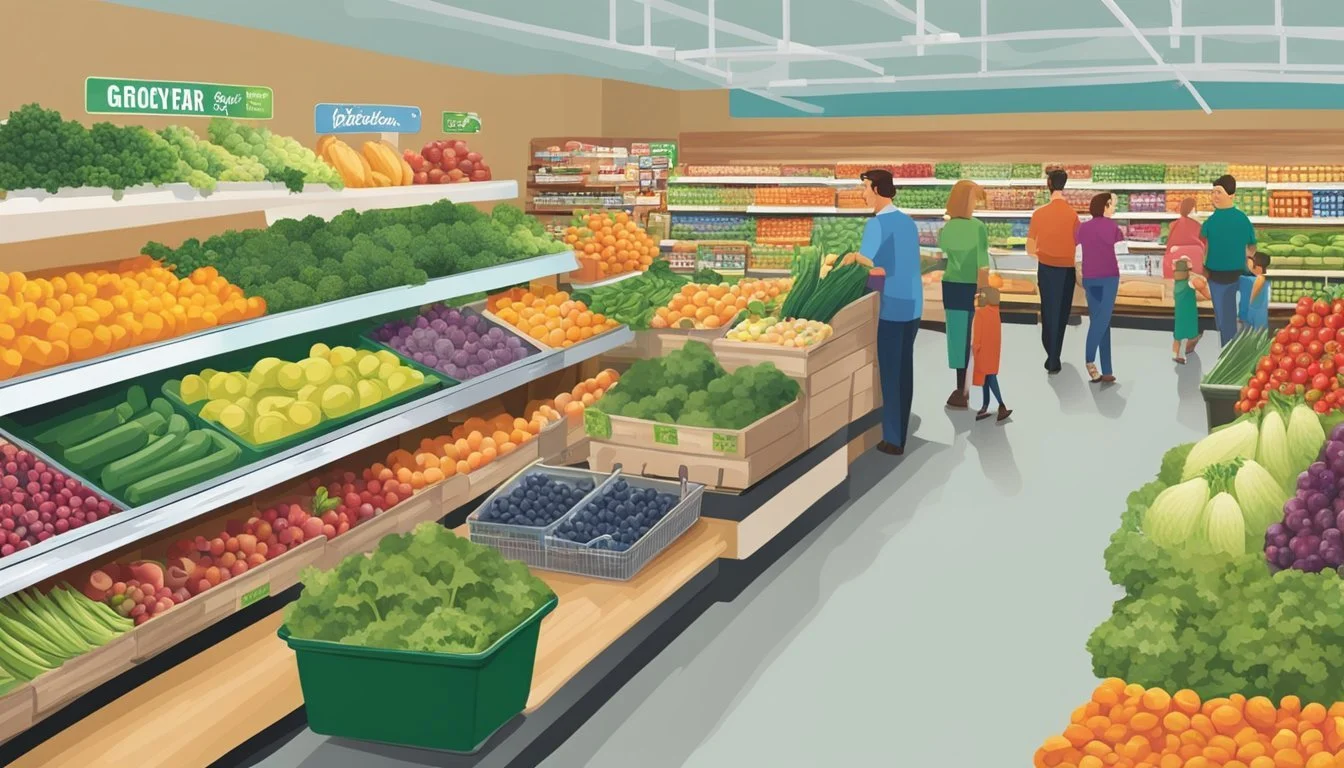Hannaford vs Whole Foods
A Comprehensive Comparison of Quality and Value
Grocery shopping is a regular necessity for most households, and choosing the right store can significantly impact both your wallet and your dining experience. Hannaford and Whole Foods are two popular supermarket chains that cater to different consumer needs and preferences. While Hannaford offers lower prices with an 11% discount compared to average grocery stores, Whole Foods is known for its high-quality organic and natural products.
Both supermarkets have their strengths and appeal to different types of shoppers. Hannaford focuses on providing affordable options across a wide range of grocery items, making it attractive for budget-conscious consumers. Whole Foods, on the other hand, emphasizes premium, health-focused products that often come with a higher price tag.
The choice between Hannaford and Whole Foods ultimately depends on individual priorities. Shoppers seeking to maximize savings on everyday items may find Hannaford more suitable, while those prioritizing organic and specialty products might prefer Whole Foods despite the higher costs. Comparing specific product offerings, prices, and store experiences can help consumers make an informed decision about which grocery store best meets their needs.
History and Overview of the Chains
Hannaford and Whole Foods represent two distinct approaches to grocery retail. Each chain has a unique history and market presence that shapes its offerings and customer base.
Hannaford's Market Presence
Hannaford traces its roots back to 1883 when Arthur Hannaford began selling produce from a cart in Portland, Maine. The company grew steadily, opening its first supermarket in 1944. By the 1970s, Hannaford had expanded throughout New England.
Today, Hannaford operates over 180 stores across five Northeastern states. The chain is known for its focus on fresh foods and competitive pricing. Hannaford emphasizes local products and sustainability initiatives.
In 2000, Hannaford became part of the Ahold Delhaize group, a major international retailer. This merger provided resources for further growth while maintaining Hannaford's regional identity.
Whole Foods and Its Acquisition by Amazon
Whole Foods Market started as a single store in Austin, Texas in 1980. The company pioneered the natural and organic foods movement in the U.S. Throughout the 1990s and 2000s, Whole Foods expanded rapidly through acquisitions and new store openings.
The chain built a reputation for high-quality, organic products and a premium shopping experience. This approach attracted a loyal customer base but also led to the nickname "Whole Paycheck" due to higher prices.
In 2017, Amazon acquired Whole Foods for $13.7 billion. This move sent shockwaves through the grocery industry. Amazon has since integrated Whole Foods into its Prime membership program and expanded delivery options.
Whole Foods now operates over 500 stores in North America and the UK. The Amazon acquisition has led to some price reductions and operational changes.
Comparison of Shopping Experience
Hannaford and Whole Foods offer distinct shopping experiences, each with its own strengths and characteristics. Their approaches to store layout, customer service, and checkout processes shape how customers interact with the supermarket environment.
Store Layout and Navigation
Hannaford stores typically feature a straightforward layout, prioritizing efficiency and ease of navigation. Aisles are clearly marked, and products are organized logically. The layout caters to families and shoppers seeking a quick, no-frills experience.
Whole Foods, in contrast, adopts a more curated approach. Their stores often have a marketplace feel, with specialty departments and artisanal displays. This layout encourages exploration and discovery, appealing to food enthusiasts and health-conscious consumers.
Both grocers offer wide aisles and clear signage, but Whole Foods tends to incorporate more open spaces and inviting product presentations.
Quality of Customer Service
Hannaford emphasizes friendly, efficient service. Staff members are generally knowledgeable about product locations and can assist shoppers quickly. The focus is on helping customers complete their shopping tasks promptly.
Whole Foods places a strong emphasis on product expertise. Their employees often receive extensive training on organic and specialty items. Shoppers can expect detailed answers about product origins, preparation methods, and dietary considerations.
Both supermarkets strive for attentive service, but Whole Foods tends to offer a more personalized, education-oriented approach.
Checkout Convenience
Hannaford offers a mix of traditional checkout lanes and self-service options. Their focus is on speed and efficiency, with well-staffed registers during peak hours. The grocer also provides mobile scanning options in some locations for added convenience.
Whole Foods has embraced technology in its checkout process. Many stores feature advanced self-checkout kiosks and mobile app integration for a seamless experience. They also offer dedicated express lanes for shoppers with fewer items.
Both chains prioritize reducing wait times, but Whole Foods often incorporates more tech-driven solutions. Hannaford's approach may be more familiar and comfortable for traditional shoppers.
Product Range and Quality
Hannaford and Whole Foods offer distinct product selections and quality standards. Their approaches to produce, meat, seafood, and specialty items cater to different customer preferences and priorities.
Produce Selection
Whole Foods prioritizes organic and locally-sourced produce. Their stores feature a wide array of fruits and vegetables, including hard-to-find varieties and seasonal specialties. Many items are clearly labeled with origin information.
Hannaford provides a solid produce selection with a mix of conventional and organic options. Their stores typically offer common fruits and vegetables at competitive prices. While the variety may be more limited than Whole Foods, Hannaford focuses on freshness and value.
Both chains emphasize quality control, but Whole Foods often receives higher marks for overall produce aesthetics and perceived freshness.
Meat and Seafood Quality
Whole Foods is known for stringent quality standards in their meat and seafood departments. They offer antibiotic-free meats, sustainably sourced seafood, and detailed information about animal welfare practices.
Hannaford provides a range of meat and seafood options, including some organic and natural choices. Their selection tends to be more mainstream, with a focus on popular cuts and species.
Whole Foods generally offers a broader selection of specialty meats and less common seafood varieties. Both stores maintain strict food safety protocols, but Whole Foods often emphasizes their higher-end offerings.
Availability of Organic and Specialty Products
Whole Foods excels in organic and specialty product availability. Their stores carry an extensive range of organic groceries, alternative diet options (vegan, gluten-free, etc.), and gourmet items.
Hannaford has expanded its organic and specialty offerings in recent years. While not as comprehensive as Whole Foods, Hannaford provides a solid selection of organic staples and some specialty products.
Whole Foods typically offers more variety in categories like international foods, artisanal cheeses, and prepared foods. Hannaford focuses on providing popular organic and specialty items that appeal to a broader customer base.
Pricing Strategies
Hannaford and Whole Foods employ distinct pricing approaches that reflect their market positioning and target customers. These strategies encompass everyday prices, promotional offers, and customer loyalty programs.
Everyday Prices of Common Items
Hannaford generally offers lower prices on everyday items compared to Whole Foods. A typical grocery basket at Hannaford can cost 10-15% less than at Whole Foods.
Hannaford focuses on providing competitive prices across a wide range of products, including both national brands and their own store brands. Their pricing strategy aims to attract budget-conscious shoppers.
Whole Foods, known for its emphasis on organic and premium products, tends to have higher everyday prices. However, they argue that the quality and sourcing of their products justify the higher costs.
Sales and Discounts
Both stores use sales and discounts to attract customers, but their approaches differ. Hannaford regularly offers weekly specials and uses loss leaders to draw shoppers into stores.
Whole Foods runs fewer storewide sales but provides targeted discounts to Amazon Prime members. These exclusive deals can offer significant savings on select items.
Hannaford's circular ads feature a wider variety of discounted items across different product categories. Whole Foods tends to focus their promotions on organic produce and specialty items.
Membership and Loyalty Programs
Hannaford's loyalty program, My Hannaford Rewards, offers personalized coupons and 2% earnings on store brand purchases. These rewards can be redeemed for future grocery savings.
Whole Foods leverages Amazon Prime as its de facto loyalty program. Prime members receive exclusive discounts and an additional 10% off sale items.
Hannaford's program is free to join, while Whole Foods' benefits require an Amazon Prime subscription. This difference in approach reflects each store's broader pricing and customer engagement strategies.
Brand Evaluations and Consumer Reports
Consumer Reports and other independent organizations have conducted evaluations of Hannaford and Whole Foods. These assessments provide valuable insights into product quality, pricing, and customer satisfaction at both grocery chains.
Independent Surveys and Ratings
Consumer Reports regularly evaluates stores and surveys customers on various aspects of the shopping experience. In recent ratings, Whole Foods received high marks for its organic and natural product selection. Hannaford scored well for its competitive pricing and store brand quality.
A Consumerpedia survey of 10,000 shoppers ranked Whole Foods above average for its prepared foods and produce quality. Hannaford earned praise for its customer service and store cleanliness.
Both chains have been recognized for their sustainability efforts. Whole Foods consistently ranks among the top eco-friendly retailers, while Hannaford has made significant strides in reducing its environmental impact.
Customer Satisfaction Reports
J.D. Power's annual grocery store satisfaction study provides insights into customer perceptions. Whole Foods typically excels in the "quality of merchandise" category, particularly among Prime members who benefit from additional discounts.
Hannaford has shown strong performance in "price and promotions" categories. Surveyed customers often cite Hannaford's loyalty program and weekly specials as key factors in their satisfaction.
Online review aggregators show mixed results for both chains. Whole Foods tends to receive higher ratings for product quality and store atmosphere, while Hannaford garners praise for its value and friendly staff.
Academic Research Findings
Researchers from Cornell University conducted a comparative study of grocery store pricing strategies. They found that Whole Foods employs a premium pricing model, particularly for organic and specialty items. Hannaford, in contrast, uses a more competitive pricing approach across product categories.
A study published in the Journal of Retailing examined customer loyalty programs. Whole Foods' integration with Amazon Prime was noted as a significant differentiator. Hannaford's My Hannaford Rewards program was praised for its simplicity and broad appeal.
Food safety researchers have evaluated both chains' practices. Whole Foods and Hannaford consistently meet or exceed industry standards for food handling and storage.
Additional Services and Amenities
Hannaford and Whole Foods offer various services beyond basic grocery shopping. These include in-store dining options, prepared food selections, and convenient grocery delivery and pickup services.
In-Store Dining and Prepared Foods
Hannaford provides a deli counter with made-to-order sandwiches and a hot food bar featuring daily specials. Their bakery offers fresh-baked breads, pastries, and custom cakes.
Whole Foods takes in-store dining a step further. Many locations feature full-service restaurants, wine bars, and extensive prepared food sections. Their hot and cold food bars offer diverse cuisines, from sushi to pizzas and salads.
Both stores prioritize quality ingredients in their prepared offerings. Whole Foods tends to have more variety and gourmet options, while Hannaford focuses on familiar favorites at lower price points.
Grocery Delivery and Pickup Services
Hannaford offers Hannaford To Go, allowing customers to order online for curbside pickup at select locations. They also partner with Instacart for home delivery in some areas.
Whole Foods provides free two-hour delivery for Amazon Prime members in select cities. They also offer curbside pickup at many stores. Customers can shop through the Amazon website or app.
Both services allow for easy reordering of favorite items. Whole Foods' integration with Amazon provides a more seamless online shopping experience, while Hannaford's service may be more accessible in certain regions.
Loyalty and Savings for Consumers
Grocery stores employ various strategies to attract and retain customers through loyalty programs and savings opportunities. These initiatives aim to provide value and incentivize repeat business.
Membership Benefits Comparison
Hannaford offers a free loyalty program called My Hannaford Rewards. Members earn 2% back on store brand purchases and receive personalized coupons. The program provides digital receipts and allows easy tracking of rewards.
Whole Foods, owned by Amazon, integrates with Prime membership. Prime members receive exclusive discounts on select items, an extra 10% off sale prices, and free 2-hour delivery in some areas. However, Prime requires an annual fee.
Walmart's free Walmart+ program offers fuel discounts, free shipping, and mobile scan-and-go shopping. This competes with Amazon Prime's grocery benefits while focusing on Walmart's strengths in pricing and convenience.
Effectiveness of Loyalty Programs
Loyalty programs can generate significant savings for frequent shoppers. A family spending $250 weekly on groceries could save over $2,000 annually through consistent use of discounts and rewards.
Program effectiveness varies based on shopping habits. Whole Foods' Prime integration may benefit those already subscribed to Amazon services. Hannaford's program appeals to store brand purchasers. Walmart's approach suits price-conscious shoppers seeking broad benefits.
Digital integration enhances program utility. Mobile apps allow easy access to rewards, personalized offers, and digital coupons. This convenience increases program engagement and potential savings.
Advertised discounts don't always translate to lowest overall prices. Consumers should compare base prices and evaluate their typical purchase patterns to determine which program offers the best value for their needs.
Market Trends and Future Outlook
Grocery retail is undergoing significant transformation driven by changing consumer preferences and technological advancements. Major players like Walmart, Target, and Amazon are reshaping the competitive landscape with innovative approaches to pricing and convenience.
Emerging Grocery Retail Trends
Online grocery shopping continues to gain traction, with retailers investing heavily in e-commerce capabilities. Many supermarkets now offer curbside pickup and home delivery options to meet customer demand for convenience.
Mobile apps are becoming essential tools for grocery shopping, allowing customers to create lists, access digital coupons, and navigate store layouts. Some retailers are experimenting with cashier-less checkout systems to reduce wait times.
Sustainability is increasingly important to consumers. Grocery stores are responding by offering more eco-friendly packaging, expanding organic product selections, and implementing food waste reduction programs.
Predictions for the Future of Grocery Shopping
Personalization will likely play a larger role in grocery retail. AI-powered systems may offer tailored product recommendations and discounts based on individual shopping habits.
Automation is expected to increase in stores and distribution centers. This could include robots for restocking shelves and autonomous vehicles for deliveries.
The line between restaurants and grocery stores may blur further. More supermarkets are likely to offer prepared meals, in-store dining options, and meal kit services to compete with food delivery apps.
Virtual and augmented reality technologies could transform the shopping experience, allowing customers to visualize recipes or nutritional information in real-time while browsing store aisles.









